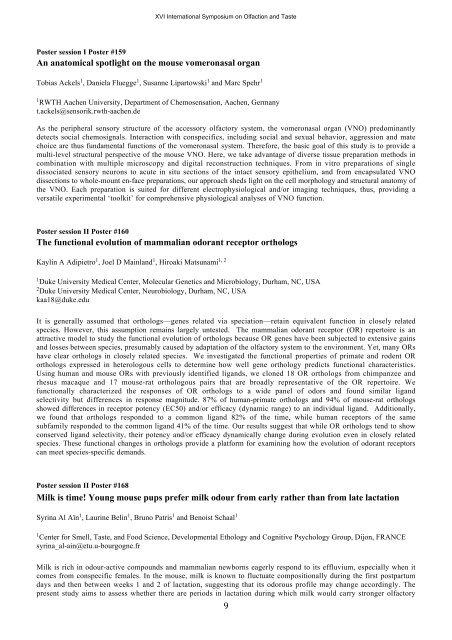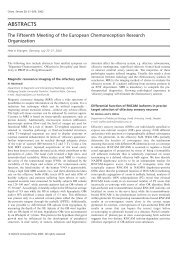XVI International Symposium on Olfaction and Taste - ecro
XVI International Symposium on Olfaction and Taste - ecro
XVI International Symposium on Olfaction and Taste - ecro
You also want an ePaper? Increase the reach of your titles
YUMPU automatically turns print PDFs into web optimized ePapers that Google loves.
<str<strong>on</strong>g>XVI</str<strong>on</strong>g> <str<strong>on</strong>g>Internati<strong>on</strong>al</str<strong>on</strong>g> <str<strong>on</strong>g>Symposium</str<strong>on</strong>g> <strong>on</strong> Olfacti<strong>on</strong> <strong>and</strong> <strong>Taste</strong><br />
Poster sessi<strong>on</strong> I Poster #159<br />
An anatomical spotlight <strong>on</strong> the mouse vomer<strong>on</strong>asal organ<br />
Tobias Ackels 1 , Daniela Fluegge 1 , Susanne Lipartowski 1 <strong>and</strong> Marc Spehr 1<br />
1 RWTH Aachen University, Department of Chemosensati<strong>on</strong>, Aachen, Germany<br />
t.ackels@sensorik.rwth-aachen.de<br />
As the peripheral sensory structure of the accessory olfactory system, the vomer<strong>on</strong>asal organ (VNO) predominantly<br />
detects social chemosignals. Interacti<strong>on</strong> with c<strong>on</strong>specifics, including social <strong>and</strong> sexual behavior, aggressi<strong>on</strong> <strong>and</strong> mate<br />
choice are thus fundamental functi<strong>on</strong>s of the vomer<strong>on</strong>asal system. Therefore, the basic goal of this study is to provide a<br />
multi-level structural perspective of the mouse VNO. Here, we take advantage of diverse tissue preparati<strong>on</strong> methods in<br />
combinati<strong>on</strong> with multiple microscopy <strong>and</strong> digital rec<strong>on</strong>structi<strong>on</strong> techniques. From in vitro preparati<strong>on</strong>s of single<br />
dissociated sensory neur<strong>on</strong>s to acute in situ secti<strong>on</strong>s of the intact sensory epithelium, <strong>and</strong> from encapsulated VNO<br />
dissecti<strong>on</strong>s to whole-mount en-face preparati<strong>on</strong>s, our approach sheds light <strong>on</strong> the cell morphology <strong>and</strong> structural anatomy of<br />
the VNO. Each preparati<strong>on</strong> is suited for different electrophysiological <strong>and</strong>/or imaging techniques, thus, providing a<br />
versatile experimental ‘toolkit’ for comprehensive physiological analyses of VNO functi<strong>on</strong>.<br />
Poster sessi<strong>on</strong> II Poster #160<br />
The functi<strong>on</strong>al evoluti<strong>on</strong> of mammalian odorant receptor orthologs<br />
Kaylin A Adipietro1 , Joel D Mainl<strong>and</strong>1 1, 2<br />
, Hiroaki Matsunami<br />
1Duke University Medical Center, Molecular Genetics <strong>and</strong> Microbiology, Durham, NC, USA<br />
2Duke University Medical Center, Neurobiology, Durham, NC, USA<br />
kaa18@duke.edu<br />
It is generally assumed that orthologs—genes related via speciati<strong>on</strong>—retain equivalent functi<strong>on</strong> in closely related<br />
species. However, this assumpti<strong>on</strong> remains largely untested. The mammalian odorant receptor (OR) repertoire is an<br />
attractive model to study the functi<strong>on</strong>al evoluti<strong>on</strong> of orthologs because OR genes have been subjected to extensive gains<br />
<strong>and</strong> losses between species, presumably caused by adaptati<strong>on</strong> of the olfactory system to the envir<strong>on</strong>ment. Yet, many ORs<br />
have clear orthologs in closely related species. We investigated the functi<strong>on</strong>al properties of primate <strong>and</strong> rodent OR<br />
orthologs expressed in heterologous cells to determine how well gene orthology predicts functi<strong>on</strong>al characteristics.<br />
Using human <strong>and</strong> mouse ORs with previously identified lig<strong>and</strong>s, we cl<strong>on</strong>ed 18 OR orthologs from chimpanzee <strong>and</strong><br />
rhesus macaque <strong>and</strong> 17 mouse-rat orthologous pairs that are broadly representative of the OR repertoire. We<br />
functi<strong>on</strong>ally characterized the resp<strong>on</strong>ses of OR orthologs to a wide panel of odors <strong>and</strong> found similar lig<strong>and</strong><br />
selectivity but differences in resp<strong>on</strong>se magnitude. 87% of human-primate orthologs <strong>and</strong> 94% of mouse-rat orthologs<br />
showed differences in receptor potency (EC50) <strong>and</strong>/or efficacy (dynamic range) to an individual lig<strong>and</strong>. Additi<strong>on</strong>ally,<br />
we found that orthologs resp<strong>on</strong>ded to a comm<strong>on</strong> lig<strong>and</strong> 82% of the time, while human receptors of the same<br />
subfamily resp<strong>on</strong>ded to the comm<strong>on</strong> lig<strong>and</strong> 41% of the time. Our results suggest that while OR orthologs tend to show<br />
c<strong>on</strong>served lig<strong>and</strong> selectivity, their potency <strong>and</strong>/or efficacy dynamically change during evoluti<strong>on</strong> even in closely related<br />
species. These functi<strong>on</strong>al changes in orthologs provide a platform for examining how the evoluti<strong>on</strong> of odorant receptors<br />
can meet species-specific dem<strong>and</strong>s.<br />
Poster sessi<strong>on</strong> II Poster #168<br />
Milk is time! Young mouse pups prefer milk odour from early rather than from late lactati<strong>on</strong><br />
Syrina Al Aïn 1 , Laurine Belin 1 , Bruno Patris 1 <strong>and</strong> Benoist Schaal 1<br />
1Center for Smell, <strong>Taste</strong>, <strong>and</strong> Food Science, Developmental Ethology <strong>and</strong> Cognitive Psychology Group, Dij<strong>on</strong>, FRANCE<br />
syrina_al-ain@etu.u-bourgogne.fr<br />
Milk is rich in odour-active compounds <strong>and</strong> mammalian newborns eagerly resp<strong>on</strong>d to its effluvium, especially when it<br />
comes from c<strong>on</strong>specific females. In the mouse, milk is known to fluctuate compositi<strong>on</strong>ally during the first postpartum<br />
days <strong>and</strong> then between weeks 1 <strong>and</strong> 2 of lactati<strong>on</strong>, suggesting that its odorous profile may change accordingly. The<br />
present study aims to assess whether there are periods in lactati<strong>on</strong> during which milk would carry str<strong>on</strong>ger olfactory<br />
9



